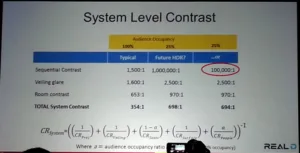That’s not exactly the message that RealD’s Pete Lude wanted to convey in his talk at the Technology Summit on Cinema, but it is was the something that exhibitors and projector makers should be considering. Why? Because in a exhaustive study of the sources of contrast degradation in a theater, having a million to one contrast projector is no better than having one with 100K:1. On the other hand, today’s DLP cinema projectors have a sequential contrast ratio that is more like 1500: 1 to 2000:1 in a totally black room, so increases do help – but there is a limit.
In a study the company has been working on for some time, they noted that there are four man contributors to the final contrast ratio reaching the eyes of the audience.
- Projector black state – sequential contrast ratio
- Projector lens veiling glare
- Auditorium ambient light level
- Auditorium contrast ratio
The sequential contrast ratio is most a measure of how dark the black state is n the projector. Anyone who has been to a theater knows there is always that glow even with no content on the screen. Black is not black. This is the area where HDR (High Dynamic Range) projectors can really increase the contrast ratio.
Projector lens veiling glare happens when a bright point on the screen sends light back into the projection lens where is reflects off multiple surfaces and shows up as a glow at some other point on the screen, reducing contrast. This is calculated by measuring the MTF from the ANSI checkerboard contrast – a conservative measurement that yields a contrast of about 1300:1. However, measured in-theater contrast varied from 400-1700:1.
The auditorium is not as dark as you might think. Those exit lights add far more light than commonly believed. Measured contrast was in the 850-980:1 range
Finally, the theater has a contrast ratio as well. This is minimized by have black light absorbing walls, carpet and seats, but according to Dolby, it can still be 5% or a contrast of 200:1. And that is with no people in the theater. Once you add people, their faces and clothes reflect more light, further degrading the contrast. Measured contrast was in the 650:1 range.
These contrasts add up as shown in the figure. The result is a real contrast of about 354:1. This level was verified by measuring 8 different theaters. But look what happens if you use an HDR projector with a contrast of 1,000,000:1. The system contrast increases significantly to 698:1. But the same result can be achieved with a projector that has 100,000:1 contrast as well, which may be a lot more easily produced and at a lower cost. This is something projector makers need to carefully consider.
Besides improving sequential contrast, projector makers should focus on improving veiling lens glare, while exhibitors can do a better job or aiming the exit signs away from the screen.
An additional surprising result was the average illumination level in the theater. RealD assumed in their calculations an 18% level meaning the average light level was at 18% of the peak luminance of 48nits (14 FtL). What they found was an average picture level of only around 6%, which makes the contrast calculations above even worse.

